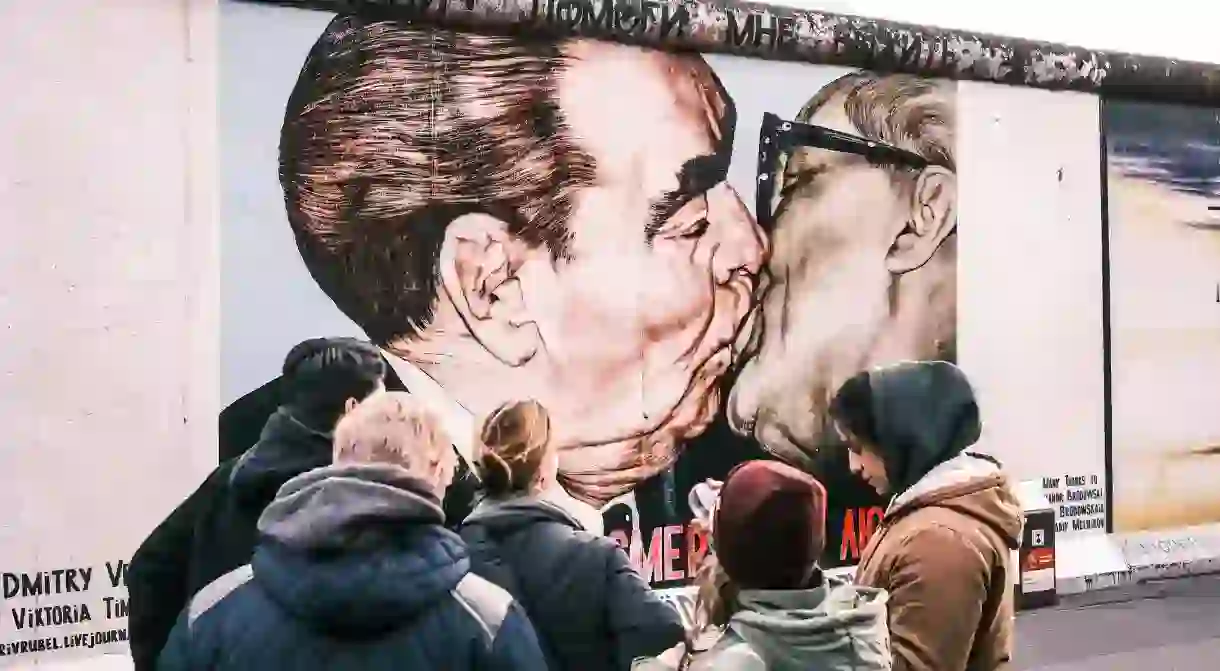The 10 Most Iconic Murals on the Berlin Wall

The Berlin Wall, once a symbol of division, now forms a large open-air gallery featuring 105 murals by artists from across the globe. Many were painted in 1990, the year after the wall fell, and the artworks that line the banks of the River Spree stand as a memorial to the reunification of Germany and to a broader moment of globally significant political change. The most striking and renowned murals include Dmitri Vrubel’s Fraternal Kiss, Birgit Kinder’s Trabant breaking through the wall and striking cartoon heads by Thierry Noir. Keen to know more? Here are the most iconic Berlin Wall murals.
'Fraternal Kiss'
Historical Landmark, Architectural Landmark

Russian artist Dmitri Vrubel’s My God, Help Me to Survive This Deadly Love, commonly known as Fraternal Kiss, depicts an embrace between Soviet leader Leonid Brezhnev and East German president Erich Honecker at the 30th anniversary of the creation of the German Democratic Republic (East Germany) in 1979. In March 2009, following the deterioration of the artwork as a result of vandalism and atmospheric conditions, the painting was erased and Vrubel was commissioned to repaint the piece. This is a staple photo op stop on any Berlin tour worth its salt, including the excellently priced Discover Berlin Half-Day Walking Tour.
Thierry Noir's cartoon heads
Memorial

Known for his signature brightly coloured cartoon heads, French artist Thierry Noir was the first person known to paint on the Berlin Wall. For five years during the 1980s, Noir illegally painted the western side of the Berlin Wall with bold, cartoonish images of animals and human faces, evading police and border guards. In part due to this dangerous environment, and his consequent need to be speedy, his murals feature few colours and avoid complex figures. Join a Cold War Walking Tour to understand the true extent to which Noir risked his life through his art.
'Thank You, Andrei Sakharov'
Memorial

'Detour to the Japanese Sector'
Architectural Landmark, Historical Landmark

'Vaterland'
Architectural Landmark, Historical Landmark

Depicting elements of the Israeli flag superimposed onto the German flag, Günther Schaefer’s Vaterland (Fatherland) was painted to honour the 50th anniversary of the Night of Broken Glass (Kristallnacht), when Nazi forces in Germany and Austria destroyed Jewish-owned shops and businesses, smashing their windows. The painting is a protest against extreme regimes and abuses of human rights, but has been a target of vandalism since it was painted in 1990. Get the most in-depth insight into the city’s tumultuous history on a Berlin Bike Tour.
The Trabant breaking through the wall
Art Gallery

'It Happened in November'
Museum

'The Wall Jumper'
Museum

'The Seven Stages of Enlightenment'
Art Gallery

'Diagonal Solution to a Problem'
Museum














